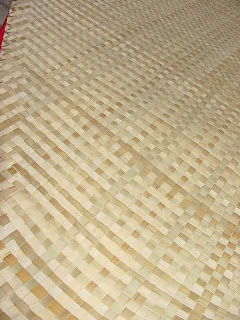 “Tikar” is a Malay word. In English, it can mean a carpet, mat, placemats or anything that can cover the floor, even your wet blankie can be considered as “tikar”.
“Tikar” is a Malay word. In English, it can mean a carpet, mat, placemats or anything that can cover the floor, even your wet blankie can be considered as “tikar”. Anyaman Tikar
The art of screwpine weaving has flourished for generations at various levels of sophistication and in varying degrees of intricacy throughout the Malay peninsula. One of its most obvious manifestations among the Malays is in the form of mat weaving. Terengganu Malay women have been known for both the fineness of their plaiting and the variety of their patterns. In traditional Malay society, a woman was not considered well prepared for life unless she developed a skill in the art of mat weaving. Hence this skill formed an integral part of character and personality development.
A vast variety of mats are created to serve different functions, decorative and functional. They are woven in traditional fashion from pandaunus (daun pandan) as well as from the screwpine (mengkuang) leaves.Those woven from daun pandan are regarded as of superior quality, for daun pandan are softer and more easily shaped compared to those woven from mengkuang, which however, are more lasting.
The process of mat weaving passes through several stages. First the pandan or mengkuang leaves are cut at the base and at both ends. The thorns and the spine of the leaves are removed and the leaves measured so that there is an even length of all in a set. This is to facilitate weaving. The strips are then passed over a slight fire to soften them. Some weavers beat the mengkuang leaves with cudgels or clubs (belantan) to make them softer and easier to handle. Once softened, they are soaked in cold water for about 48 hours with the water being changed on the second morning. This is done to remove any natural elements likely to attract insects to the mats.
Kelarai or ragi are named and shaped after flowers, bamboo as well as other rural elements or pursuits.Kelarai Pucuk Rebung, Kelarai Siku Keluang, Kelarai Bunga Cina, Kelarai Bunga Cengih and Kelarai Jari Kedidi are some of the traditional designs still in use today.
Pandan weaving, however does not end merely at mats. Other products iinclude fans, baskets, pouches or purses,sunhats, as well as dish covers, which enjoy a special place in most Malay kitchens.



No comments:
Post a Comment